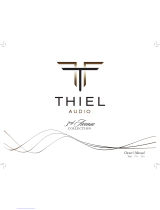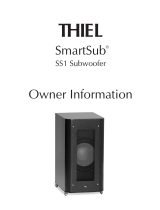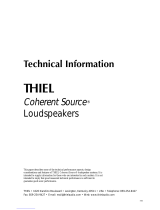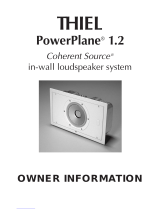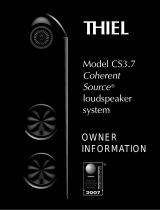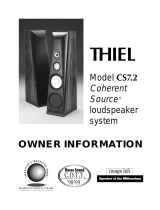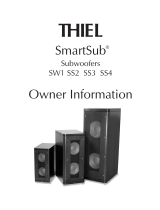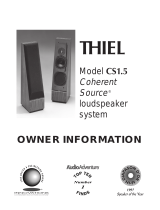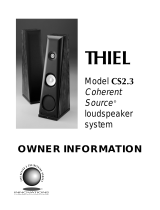Page is loading ...

AUDIO/NOVEMBER 1994
THIEL CS1.5
SPEAKER
T
he current trend in loudspeakers is to
make them as small as possible, hide
them in walls, or have a system that
consists of small left and right satellites
with a separate woofer or subwoofer.
There are, however, practical limits to
how small you can make a really good speaker
and to how well you can hide one. Trying to get
full-range performance from a small speaker
always means a sacrifice in bass capability. Build-
ing a speaker into a wall virtually always means
a major sacrifice in soundstage performance and
often in frequency response as well. Using a
separate woofer or subwoofer almost always
means audible problems in the crossover re-
gion—unless the crossover frequency is well
below 100 Hz.
Thiel takes a different approach in the CS1.5,
a full-range floor-standing loudspeaker clearly
designed to be kept several feet away from the
side and rear walls. At the same time, it is rela-
tively compact, measuring 8 1⁄2 inches wide, 11
inches deep, and 33 inches high. Its low visual
profile and sloping front, together with the fact
that it is deeper than it is wide, make it seem
smaller than it is.
I’d much rather live with the visual image of
a small floor-standing loudspeaker like this Thiel
than with the more obtrusive look of a box
speaker placed on many of the stands I’ve seen
recently. And while the Thiel CS1.5 is, at $1,990
per pair, not inexpensive, a true price compari-
son with small shoe-box sized speakers must
include the cost of stands. You will never get
top performance by locating any loudspeaker
worthy of the name on a piece of furniture or
in a bookshelf.
The Thiel’s cabinet is very well finished, with
an attractive grille that does not have to be re-
moved for best performance. The cabinet walls
are an inch thick and have extensive internal
bracing to reduce vibration. The baffle is sloped
to provide proper phase alignment and transient
AURICLE
THE EQUIPMENT AUTHORITY
NOVEMBER 1994
Reprinted with permission
from Audio © 1994 Hachette
Filipacchi, Inc.

AUDIO/NOVEMBER 1994
information and, like that most other high-qual-
ity speakers, has smooth, round edges to reduce
energy diffraction and provide a more open
sound.
The tweeter is a 1-inch metal dome with a
large magnet, vented pole piece, and reinforced
rear chamber for low resonant frequency and
wide bandwidth. The 6 1/2 -inch woofer uses a
treble. While there do seem to be some small
irregularities in the response somewhere around
4 kHz, I did not hear any that significantly col-
ored voice, piano, or guitar.
Furthermore, the Thiel has a great deal of
transient detail and resolving power. It may not
match the best ribbon speakers in this regard,
but it is the equal of many electrostatics and is
much better in reproducing subtle, low-level
musical and soundstage detail than most of the
small to moderate-sized monitors that I have
auditioned. The CS1.5 also is as fast and de-
tailed in the upper bass and lower midrange as
it is in the upper midrange and treble—out-
standing performance in this price range.
The Thiel CS1.5 does not seem to favor one
kind of music or recording over another. These
speakers simply give you what is on your re-
cordings, without coloring or romanticizing—a
naturalness that is particularly welcome on voice
and strings but also comes through quite clearly
on solo piano and percussion sounds such as
cymbal and snare drum.
This accuracy in frequency and detail is
matched by good soundstage performance. The
CS1.5 does not dramatize the soundstage or
produce a large and open soundstage with ev-
ery recording. Depth and width are natural
rather than “exciting.” If anything, the
soundstage is just a bit smaller than normal. The
apparent listening position is a bit forward, and
there is a feeling of being slightly above the
soundstage.
The CS1.5 does a very good job of making
naturally recorded stereo music sound natural.
Many small monitors impose a fixed soundstage
on the music they reproduce; for good or bad,
they become the concert hall and alter the music
accordingly. The soundstage of the Thiel may
initially seem understated by comparison, but
what you hear is the recording and not the
speaker. Imaging is equally natural. Some small
stand-mounted monitors almost “etch”: the
imaging, providing a more defined image for
each instrument than is actually on the record-
ing. The CS1.5s do not artificially fix the image
in place, and they do not alter its size.
The Thiel’s bass, however, is not deep or
powerful by high-end standards. This may
present problems in large rooms or where bass
power is a key consideration. The CS1.5 cer-
tainly has as much or more bass than most
speakers its size, and it does produce consider-
able power to below 50 Hz, if not much below
45 Hz. It has exceptional bass detail within its
range, and its bass response rolls off very
smoothly, without the boost or hump that many
small and medium-sized monitors exhibit just
above their bass cutoff frequency.
Coupled to the speaker’s flat and extend
treble, this lack of added bass warmth or boost
can make the CS1.5 seem a bit lean and lacking
in bass energy. This is likely if you place the
cabinet 3 feet from a rear wall and 5 feet from
a side wall, as called for in Thiel’s instructions.
Try the CS1.5s in a medium-sized room, and
place them closer to the rear wall for a touch of
room reinforcement. Also, use the spiked feet
and avoid an amplifier that is dry or lean.
The CS1.5 is capable of excellent dynamics
and a surprising amount of output, bettering
many speakers in these respects. Fine for classi-
cal, jazz, and most rock, it’s a speaker for those
who enjoy music and accuracy more than sheer
power.
The Thiel CS1.5 is an excellent example of
how far medium-sized monitors have come in
the last few years. It may not have the deep
bass or dynamic range of its more expensive sib-
lings—and if I had the money, I would prefer
the Thiel CS3.6. That speaker, though, costs
almost twice as much. What the CS1.5 does
provide is an excellent soundstage and upper
BASS DETAIL IS
EXCEPTIONAL, AND
RESPONSE ROLLS OFF
SMOOTHLY, WQITHOUT
A BOOST OR HUMP.
bass, midrange, and treble I’d associate with
speakers costing a great deal more. With the
right placement, the CS1.5 is an outstanding
buy, one that makes true high-end sound af-
fordable. Anthony H. Cordesman
THE CS1.5s GIVE YOU
WHAT IS ON YOUR
RECORDINGS, WITHOUT
COLORIZING OR
ROMANTICIZING.
rigid aluminum diaphragm to eliminate cone
break -up and energy storage; a short-coil, long-
gap magnet to reduce distortion, and a copper
pole piece to maintain a stable magnetic field.
The woofer has two magnets with a total weight
of more than 2.4 pounds; the second magnet
has reversed polarity to reduce the stray mag-
netic field of the loudspeaker and allows the
CS1.5 to be positioned nearer the TV in an
audio/video system. There is a passive bass ra-
diator to lower bass resonance and eliminate
possible vent noise. The 18-element, first-order
crossover is phase-accurate and uses polypro-
pylene capacitors and low-oxygen, air-core in-
ductors.
Frequency response is ±3 dB from 42 Hz to
22 kHz. Thiel’s detailed frequency response
curves exhibit exceptionally smooth perfor-
mance from 50 Hz to 2 kHz and only minor
irregularities up to beyond 20 kHz. The 30° off-
axis response is very close to the main-axis re-
sponse and is only about 5 dB down at 20 kHz.
Time and step responses are also very good, re-
vealing exceptionally fast, clean response, with
excellent phase coherence.
The only caution I would give about the
specs is that the speaker’s rated 4-ohm imped-
ance drops to as low as 3 ohms. I did not find
that the CS1.5 posed any problems for well-
designed power amplifiers, and it did not seem
to be a difficult load. There are, however, a num-
ber of receivers and a few power amps that don’t
perform well with low-impedance speakers.
The first things that struck me about the
sound of the Thiel were its smoothness and
speed. The term “monitor” is much overworked,
but it is perhaps the best term to apply to the
CS1.5. There is very little coloration in the
midrange and no roll-off or exaggeration in the
AUDIO
is published monthly by Hachette
Filipacchi Magazines at 1633 Broadway,
New York, NY 10019. Subscription inquiries
call 303-447-9330.
/

